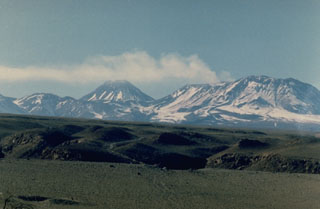Report on Lascar (Chile) — December 1989
Scientific Event Alert Network Bulletin, vol. 14, no. 12 (December 1989)
Managing Editor: Lindsay McClelland.
Lascar (Chile) Strong steam plumes
Please cite this report as:
Global Volcanism Program, 1989. Report on Lascar (Chile) (McClelland, L., ed.). Scientific Event Alert Network Bulletin, 14:12. Smithsonian Institution. https://doi.org/10.5479/si.GVP.SEAN198912-355100
Lascar
Chile
23.37°S, 67.73°W; summit elev. 5592 m
All times are local (unless otherwise noted)
Strong steam eruptions were observed by Stephen Foot on 17 December between 0915 and 0930, and on 21 December at 1130. In each instance, fumarolic activity changed from the normal emission of a small diffuse plume to ejection of a very dense white cloud that rose ~2 km above the crater for ~15 minutes. The clouds were opaque and produced a heavy shadow. The plumes then diminished in height, remaining near the volcano for about an hour, then moved N on the 17th and NE on the 21st. No recent precipitation had occurred in the area.
Geological Summary. Láscar is the most active volcano of the northern Chilean Andes. The andesitic-to-dacitic stratovolcano contains six overlapping summit craters. Prominent lava flows descend its NW flanks. An older, higher stratovolcano 5 km E, Volcán Aguas Calientes, displays a well-developed summit crater and a probable Holocene lava flow near its summit (de Silva and Francis, 1991). Láscar consists of two major edifices; activity began at the eastern volcano and then shifted to the western cone. The largest eruption took place about 26,500 years ago, and following the eruption of the Tumbres scoria flow about 9000 years ago, activity shifted back to the eastern edifice, where three overlapping craters were formed. Frequent small-to-moderate explosive eruptions have been recorded since the mid-19th century, along with periodic larger eruptions that produced ashfall hundreds of kilometers away. The largest historical eruption took place in 1993, producing pyroclastic flows to 8.5 km NW of the summit and ashfall in Buenos Aires.
Information Contacts: S. Foot, MINSAL Ltda., Santiago; M. Gardeweg, SERNAGEOMIN, Santiago.

